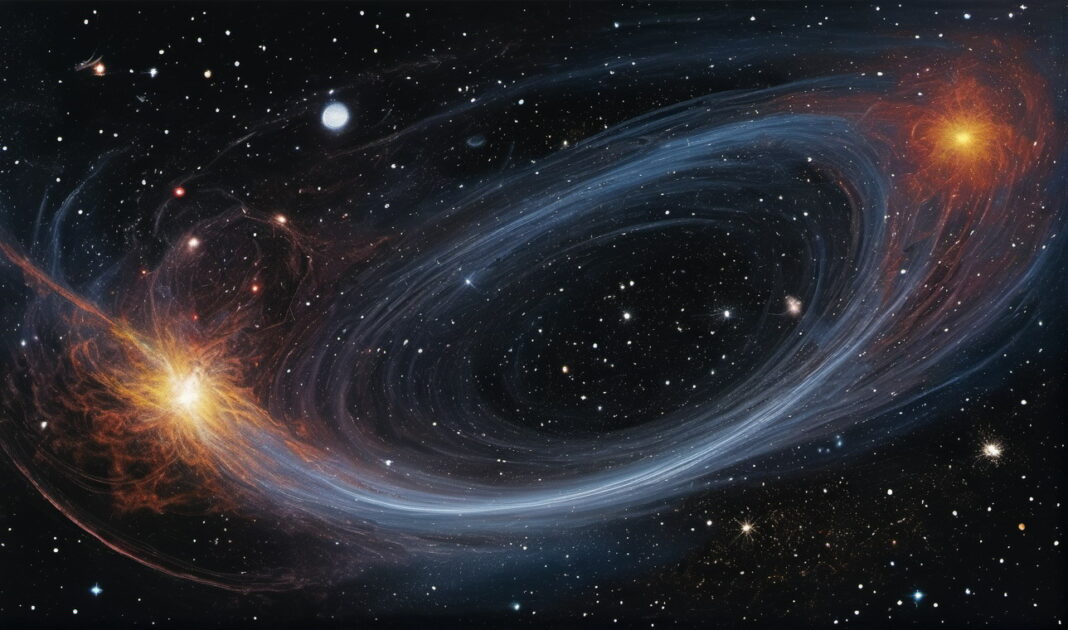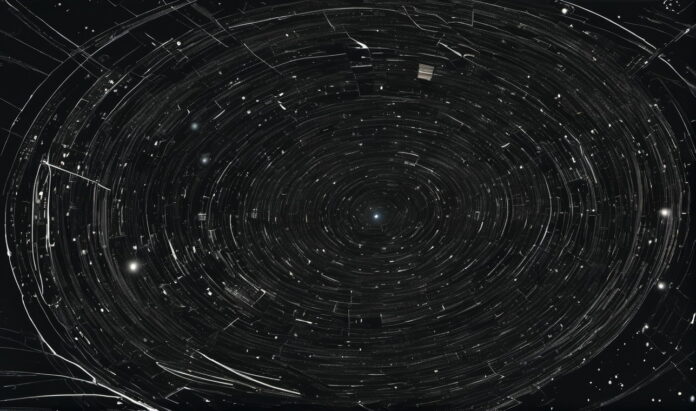Some cosmic objects behave strangely, violating the laws of celestial mechanics. Their orbits deviate from those calculated and modeled by computers. Apparently, they are subject to some powerful gravitational influence, causing them to deviate from the calculated trajectory. However, there are no stars or galaxies nearby that could exert such an influence on the object!
Therefore, astronomers believe that there is a substance in space that cannot be seen with the naked eye or even with the most powerful telescope. However, this substance has a very strong gravitational field that affects other cosmic objects near it, making it possible to detect it. Scientists call this substance Dark Matter.
Some astronomers are convinced that a quarter of our Universe consists of this matter, while others claim that the mysterious substance makes up to 85% of the Universe. But neither its composition nor its basic physical properties have been studied so far. Let’s clarify right away that all further statements are based solely on the theories of scientists and are not yet confirmed by anything.
So what is dark matter and where did it come from?
It is assumed that dark matter appeared at the moment of the Big Bang. There is a version that it existed even earlier, during the period of the so-called cosmological inflation. At first, the Universe was relatively homogeneous and filled with elementary particles.
But as it evolved, it became more “clumpy”: accumulations of matter were divided by huge empty spaces stretching for millions of light-years. Naturally, the question arises: why did the Universe change its structure? Most likely, the “culprit” is precisely dark matter.

This substance was always distributed unevenly. That is, somewhere there was more of it, somewhere – much less. In places of its large accumulations, strong gravitational attraction arose, which attracted ordinary matter. At some point, the accumulating substance under the influence of its own enormous mass literally ignited, turning into stars.
But what is dark matter, which probably made the Universe what it is? Scientists still cannot answer this question definitively. After all, it is impossible to find something invisible to the naked or armed eye.
Particles that make up dark matter can be the lightest in the Universe, or they can have a mass comparable to the mass of a small planet. Dark matter has no temperature, it does not emit or absorb light…
Unfortunately, to date, no experiment has been able to produce particles from which dark matter consists, so it is not yet possible to say exactly what it really is.
Who discovered it?
The idea of dark matter was first proposed by astrophysicist Fritz Zwicky in 1933. He put forward his hypothesis after observing a cluster of galaxies that behaved strangely. Their masses were insufficient to move at the observed speed.
Zwicky wondered why this was happening. The only explanation was the presence of some invisible matter that had gravitational influence but could not be directly observed.
In the late 1970s, astrophysicists Kent Ford and Vera Rubin observed the Andromeda galaxy. According to them, objects located on the periphery of the galaxy should rotate more slowly than those closer to its core. However, this was not the case.
Peripheral objects rotated much faster than predicted based on cosmological laws and their assumed mass. Researchers concluded that this could only be explained by the presence of unknown matter – dark matter.
How does it manifest itself?
The influence of dark matter is manifested not only in deviations in the speeds of cosmic objects. There is another interesting phenomenon called “gravitational lensing”. Light rays consist of particles that tend to deflect under the influence of gravitational fields.
That is, any large cosmic object refracts rays, making their source appear larger or brighter and acting like a magnifying glass. Naturally, the larger the object, the greater its effect on the flow of photons. For example, galaxies or large star clusters refract light more strongly than can be assumed based on their mass. This phenomenon also suggests the presence of some “hidden” matter in space.
What forms of matter exist at all?
Until recently, scientists identified two forms of matter: substance and field. Matter consists of microscopic particles. For example, neutron matter consists of neutrons, and baryonic matter consists of baryons. In our galaxy, most of the matter consists of fermions.
In matter, there are voids between particles. Unlike matter, the field does not have such voids. Physicists say that it has absolute density. As an example, gravitational and electromagnetic fields can be cited.
However, the concept of matter, which has only two forms (substance and field), turned out to be insufficient to explain some cosmological phenomena, in particular, anomalous cosmic gravitational fields that seem to arise on their own, without being tied to a specific object. Therefore, the concept of dark matter was introduced.
Dark energy
Presumably, the Universe consists of 25% dark matter and 5% substance. What about the remaining 70%? It is assumed that this share falls on dark energy. It is even more mysterious than dark matter. It has anti-gravity and therefore is evenly distributed without clumps.
Dark matter is a substance that made the Universe what it is. It affects the evolution of stars and planets, the speed of movement of cosmic objects, and perhaps it is from it that black holes “are born”… But what is dark matter really? Scientists have yet to find out the answer…
